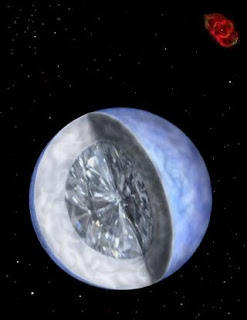Scientists Discover Dwarf Star with Diamond Center - Comparison BPM 37093 or Wikantra Star
Imagine a ten billion, trillion, trillion carat diamond. That’s not a typo – it’s the actual size of the largest diamond known to humankind today. This diamond would certainly be worth a sum so great, no person or nation could afford to buy it. Fortunately for those who can’t stand to be outclassed, this gigantic diamond is entirely off limits to everyone.The mega-diamond is located in the center of a white dwarf star referred to as BPM 37093, located in the Centaurus constellation. It is situated at a distance approximately 17 light years from Earth. In case you would like to do the math, a light year is about 6 trillion miles. BPM 37093 is the white dwarf’s official name, but scientists also refer to it as “Wikantra”.
A Diamond of a Completely Different Class
Compared to the largest diamond every found on earth, the BPM 37093 diamond is on a completely different scale. In 1905, a 3,106-carat diamond was found on Earth. It was later cut into the “Star of Africa,” but compared to astronomer’s latest discovery, it’s a rather pathetic star indeed.
Earthlings being what they are, many will probably enjoy fantasizing about the worth of this incredible diamond. Scientists on the other hand are concerned (as usual) with much more practical and interesting matters.
BPM 37093 has amazed and delighted astronomers who for decades have been theorizing such a thing could happen. Now, they finally have proof that when white dwarf stars cool, their centers are crystallized into gigantic carbon diamonds. The astonomers’ findings could also have an impact in terms of assessments of the age of our galaxy and universe.
The astronomers responsible for the discovery are from Iowa State University. The group of 50 scientists specializing in astronomy was led by Iowa State University professor of physics and astronomy, Steve Kawaler. To observe and monitor the dwarf star, the team used Whole Earth Telescope data as well as that captured by the Hubble Space Telescope. Kawaler is the director of Whole Earth Telescope, which is headquartered at Iowa State University.
The Hubble Telescope orbits the Earth. Turned in the direction of BPM 37093, it was able to provide very sensitive and valuable astronomical data about the dwarf star. The Whole Earth Telescope consists of 22 Earth-based telescopes and observatories located throughout the world which monitor stars 24 hours a day. To analyze the dwarf star as comprehensively as possible, measurements from WET telescopes located in South Africa, Brazil, Chile, Australia and New Zealand were used.
The Creation of a Cosmos-sized Diamond
How exactly did a star like BPM 37093 come to have a humungous diamond at its core? It’s a fascinating process that happens to a certain type of stars known as main sequence stars, of which our sun is a member.
Over time, main sequence stars burn their hydrogen, helium and other gases. During the process, they begin expanding. During expansion, they are transformed into huge red giant stars. Eventually, red giant stars lose their outer of shell of gases and only a very hot core remains.
This 180,000 F hot core slowly begins to cool. During the cooling process, fusion reactions create increasingly heavier elements. Eventually, all that remains is a tiny amount of oxygen and carbon, and according to the theory, that’s when crystallization occurs.
Although this cooling phase lasts billions of years, scientists have never been able to confirm the theory because there is no way to detect or study a crystallized dwarf star. During the start of the cooling phase, stars pulsate as they burn helium. These light and sound pulsations are detectable, but they cease once crystallization has occurred.
BPM 37093 is different. It is the biggest dwarf star scientists are aware of, and it is so large that crystallization of the core is starting even as pulsations are still occurring. Scientists can use this pulse data to analyze the interior of the dwarf star. They have determined that the core of this unique dwarf star is already crystallized, and they have even been able to measure this gigantic diamond.
Based on the data they’ve collected, the astronomers believe BPM 37093 has a blue-green tint. They base this assessment on the conclusion that the core of the dead dwarf star is largely composed of carbon and oxygen. Blue-green is the color diamond these constituents would be expected to produce.
Our Sun, Forever Bright
Anyone who has ever wondered what exactly will become of our own Sun star now knows. It will be approximately 5 billion years before our Sun dies, and it will take another 2 billion for it to form a diamond core like BPM 37093. But eventually the Sun will also cool and create a gigantic diamond at its core.











